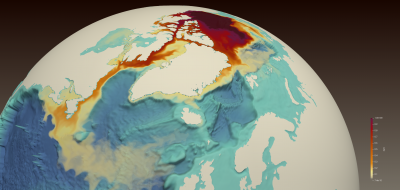Labrador Sea Freshening Sourced From the Western Arctic Ocean
The Beaufort Gyre in the western Arctic Ocean is the largest oceanic freshwater reservoir in the Northern Hemisphere. It has accumulated an unprecedented amount of freshwater in the past two decades. But the fate of the excess freshwater, if released into the North Atlantic, and its impact on ocean salinity are not well known. Here we show that a historical release during 1983-1996 freshened the western Labrador Sea by as much as 0.2 psu. The results imply that a future release of the current high volume of Beaufort Gyre freshwater could even be more impactful.
This study is the first that quantifies the fate of the Beaufort Gyre freshwater after it is released and its downstream impact. The results have the potential to shift the somewhat Euro-centric thinking about Arctic outflows towards the North American side. The methods employed in the study, namely the novel tracer design and its diagnosis, provide a new way to quantify the downstream impact on salinity from any seawater mass of interest.
This study shows that the Canadian Archipelago straits, rather than Fram Strait, is a key pathway in transmitting the Beaufort Gyre freshwater to the Atlantic. The salinity change at the western Labrador Sea shelves induced by a historical Beaufort Gyre freshwater release episode from 1983 to 1996 is comparable to that induced by current and expected near-future Greenland meltwater fluxes. The results are based on passive tracers implemented in a global intermediate-resolution ocean sea-ice model, which is performed at the High Performance Computing facility at Los Alamos National Laboratory.

